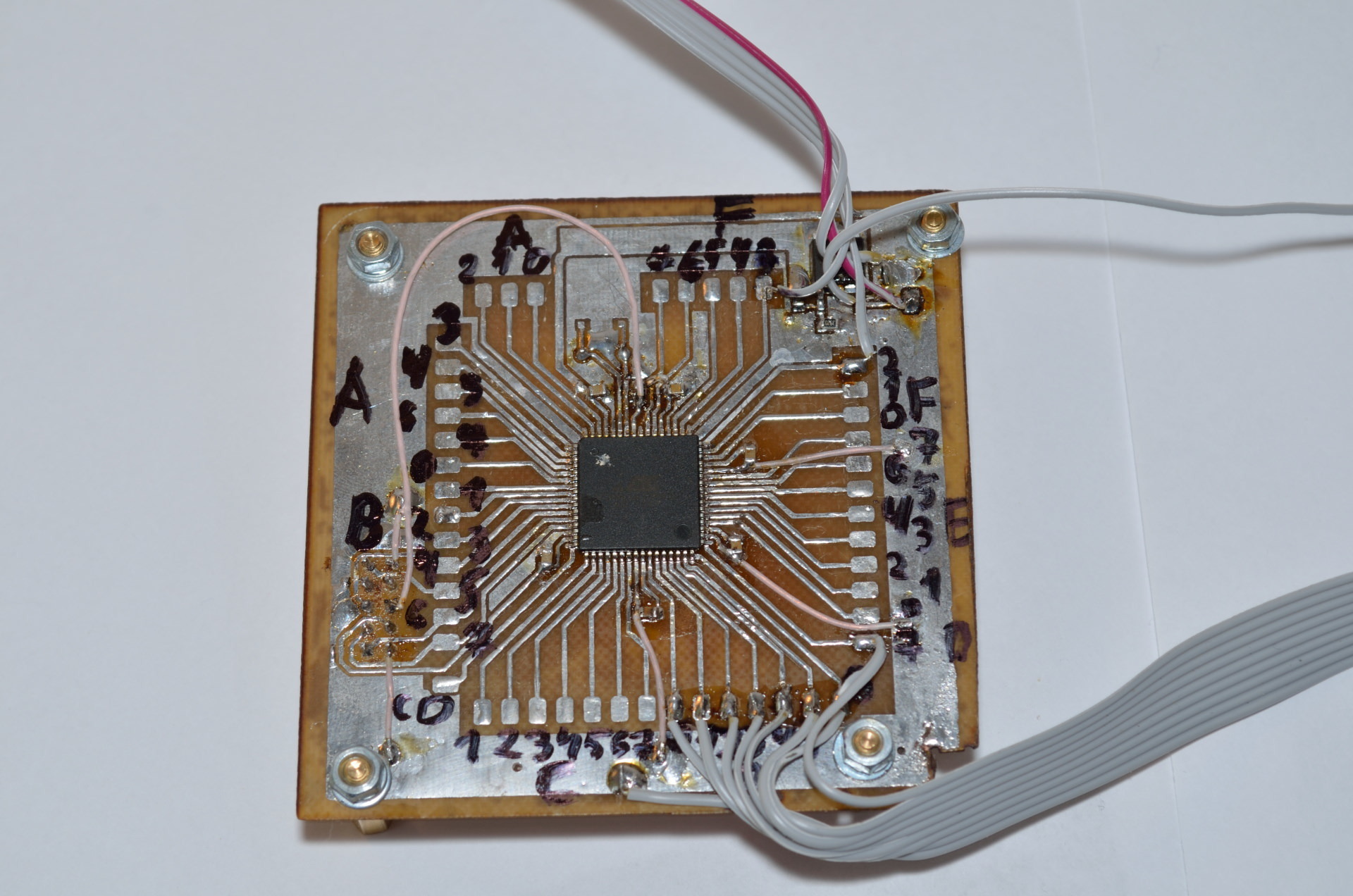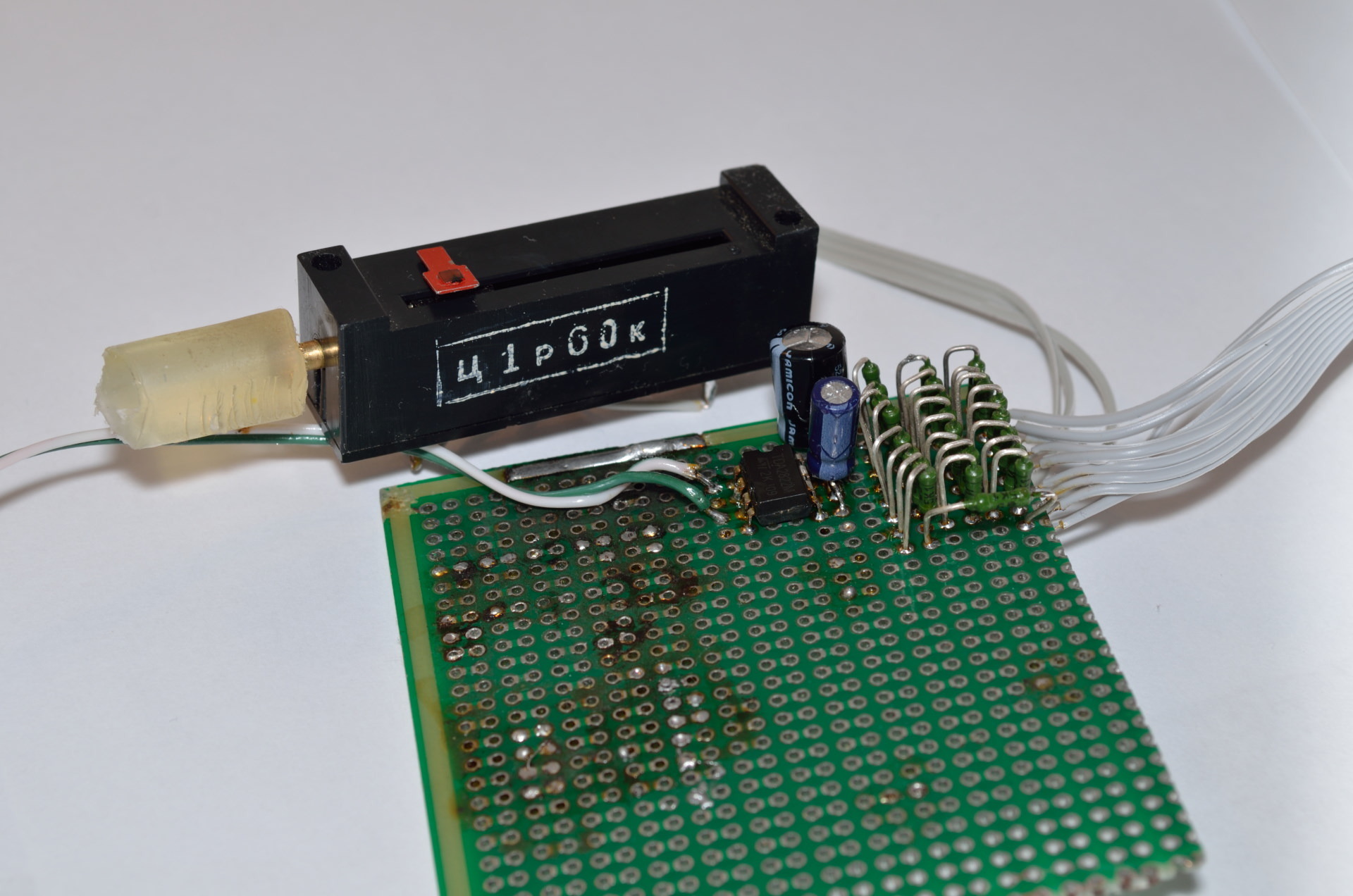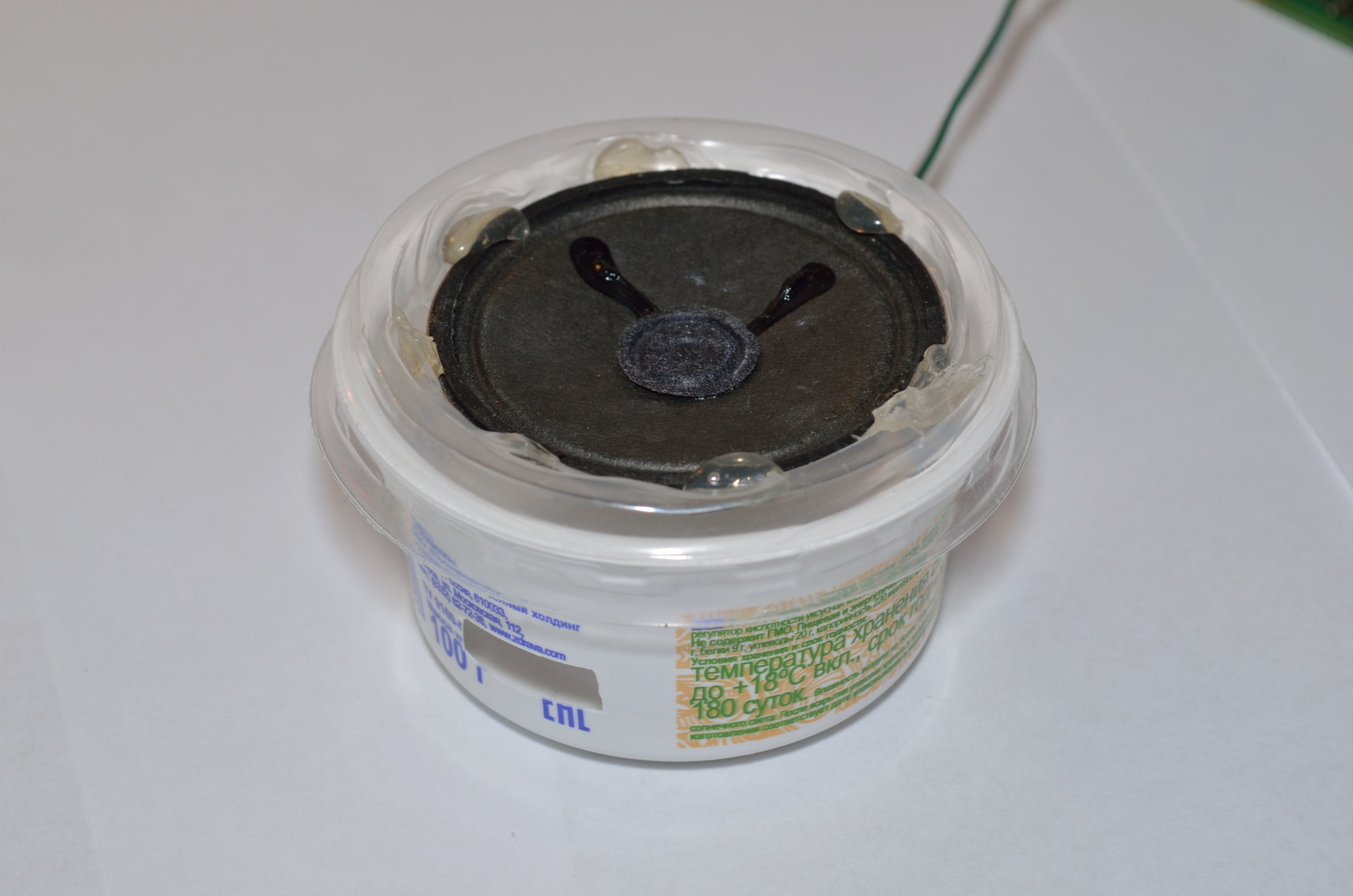![[Из песочницы] Аудио плеер на AVR [Из песочницы] Аудио плеер на AVR](https://habrastorage.org/files/6f7/134/c40/6f7134c4060240dfa4f58827e840943c.jpg)
Во время очередной ревизии радиоэлектронного барахла и распихивания по коробочкам мне попался контроллер AVR atxmega256a3u. Дабы развеять скуку было решено сделать некое подобие звуковой карты, а точнее ЦАП, подключаемый к компьютеру. Что из этого получилось смотрите под катом.
Линейка микроконтроллеров XMEGA является развитием знакомых большинству любителей электроники контроллеров MEGA, добавлено много интересных плюшек, но все описанное ниже можно реализовать на традиционной серии. Рекомендую лишь использовать те контроллеры, где побольше ОЗУ.
От слов к разработке, поразмыслив пришел к такой структуре устройства:

Буду воспроизводить музыку из WAV-файлов, моно, 8 бит с частотой дискретизации 44.1 кГц. Посылка последовательного порта состоит из 10 бод (стартовый и стоповый биты, 8 битов данных), значит требуется скорость не ниже 441 кБод/с. Аппаратура позволяет работать быстрее, беру с запасом скорость передачи данных 2000 кБод/с.
Внутри контроллера буфер FIFO, он же очередь «первый пришел — первый вышел». По таймеру с частотой 44.1 кГц запускается прерывание извлекающее из буфера очередной отсчет и передающее его цифро-аналоговому преобразователю, а также по необходимости выполняется запрос очередного пакета данных у ЭВМ. Размышляя обо всем этом трассирую и травлю «отладочную» плату для микроконтроллера:

Самым интересным в этой разработке пожалуй является ЦАП. В моем микроконтроллере есть встроенный ЦАП, но использовать его не спортивно, к тому же в большинстве микроконтроллеров такой роскоши нет. Ничего страшного, ЦАП можно сделать самому из горсти резисторов по схеме R-2R:

Такая схема позволяет получить на выходе напряжения в диапазоне от 0 В до уровня логической единицы, в моем случае это 3.3 В. Сделаю восьмибитный ЦАП, у меня под рукой лишь резисторы с допустимым отклонением 5%, а значит точность потеряется с пятого разряда поскольку (1/2^5)<0.05. Тем не менее, надеюсь, что младшие разряды позволят озвучить слабые спектральные составляющие сигнала. Собираю из резисторов номиналом 5.1 кОм вот такого монстра:

Тут же ставлю усилитель TDA2822M, подключаю по мостовой схеме из даташита:
И делаю колонку с фазоинвертором:

Пора послушать:
Звучит более-менее терпимо, если подключить динамик побольше становится получше.
// I/O Registers definitions #include // Declare your global variables here #define fSIZE 12000 int rAdr,wAdr,dn; char needdata; char fifo[fSIZE]; // System Clocks initialization void system_clocks_init(void) { unsigned char n,s; // Optimize for speed #pragma optsize- // Save interrupts enabled/disabled state s=SREG; // Disable interrupts #asm("cli") // External 16000,000 kHz oscillator initialization // External Clock Source - Startup Time: 0.4-16 MHz Quartz Crystal - 16k CLK OSC.XOSCCTRL=OSC_FRQRANGE_12TO16_gc | OSC_XOSCSEL_XTAL_16KCLK_gc; // Enable the external oscillator/clock source OSC.CTRL|=OSC_XOSCEN_bm; // System Clock prescaler A division factor: 1 // System Clock prescalers B & C division factors: B:1, C:1 // ClkPer4: 16000,000 kHz // ClkPer2: 16000,000 kHz // ClkPer: 16000,000 kHz // ClkCPU: 16000,000 kHz n=(CLK.PSCTRL & (~(CLK_PSADIV_gm | CLK_PSBCDIV1_bm | CLK_PSBCDIV0_bm))) | CLK_PSADIV_1_gc | CLK_PSBCDIV_1_1_gc; CCP=CCP_IOREG_gc; CLK.PSCTRL=n; // Wait for the external oscillator to stabilize while ((OSC.STATUS & OSC_XOSCRDY_bm)==0); // Select the system clock source: External Oscillator or Clock n=(CLK.CTRL & (~CLK_SCLKSEL_gm)) | CLK_SCLKSEL_XOSC_gc; CCP=CCP_IOREG_gc; CLK.CTRL=n; // Disable the unused oscillators: 2 MHz, 32 MHz, internal 32 kHz, PLL OSC.CTRL&= ~(OSC_RC2MEN_bm | OSC_RC32MEN_bm | OSC_RC32KEN_bm | OSC_PLLEN_bm); // ClkPer output disabled PORTCFG.CLKEVOUT&= ~(PORTCFG_CLKOUTSEL_gm | PORTCFG_CLKOUT_gm); // Restore interrupts enabled/disabled state SREG=s; // Restore optimization for size if needed #pragma optsize_default } // Ports initialization void ports_init(void) { // PORTA initialization // OUT register PORTA.OUT=0x00; // Pin0: Input // Pin1: Input // Pin2: Input // Pin3: Input // Pin4: Input // Pin5: Input // Pin6: Input // Pin7: Input PORTA.DIR=0x00; // Pin0 Output/Pull configuration: Totempole/No // Pin0 Input/Sense configuration: Sense both edges // Pin0 Inverted: Off // Pin0 Slew Rate Limitation: Off PORTA.PIN0CTRL=PORT_OPC_TOTEM_gc | PORT_ISC_BOTHEDGES_gc; // Pin1 Output/Pull configuration: Totempole/No // Pin1 Input/Sense configuration: Sense both edges // Pin1 Inverted: Off // Pin1 Slew Rate Limitation: Off PORTA.PIN1CTRL=PORT_OPC_TOTEM_gc | PORT_ISC_BOTHEDGES_gc; // Pin2 Output/Pull configuration: Totempole/No // Pin2 Input/Sense configuration: Sense both edges // Pin2 Inverted: Off // Pin2 Slew Rate Limitation: Off PORTA.PIN2CTRL=PORT_OPC_TOTEM_gc | PORT_ISC_BOTHEDGES_gc; // Pin3 Output/Pull configuration: Totempole/No // Pin3 Input/Sense configuration: Sense both edges // Pin3 Inverted: Off // Pin3 Slew Rate Limitation: Off PORTA.PIN3CTRL=PORT_OPC_TOTEM_gc | PORT_ISC_BOTHEDGES_gc; // Pin4 Output/Pull configuration: Totempole/No // Pin4 Input/Sense configuration: Sense both edges // Pin4 Inverted: Off // Pin4 Slew Rate Limitation: Off PORTA.PIN4CTRL=PORT_OPC_TOTEM_gc | PORT_ISC_BOTHEDGES_gc; // Pin5 Output/Pull configuration: Totempole/No // Pin5 Input/Sense configuration: Sense both edges // Pin5 Inverted: Off // Pin5 Slew Rate Limitation: Off PORTA.PIN5CTRL=PORT_OPC_TOTEM_gc | PORT_ISC_BOTHEDGES_gc; // Pin6 Output/Pull configuration: Totempole/No // Pin6 Input/Sense configuration: Sense both edges // Pin6 Inverted: Off // Pin6 Slew Rate Limitation: Off PORTA.PIN6CTRL=PORT_OPC_TOTEM_gc | PORT_ISC_BOTHEDGES_gc; // Pin7 Output/Pull configuration: Totempole/No // Pin7 Input/Sense configuration: Sense both edges // Pin7 Inverted: Off // Pin7 Slew Rate Limitation: Off PORTA.PIN7CTRL=PORT_OPC_TOTEM_gc | PORT_ISC_BOTHEDGES_gc; // Interrupt 0 level: Disabled // Interrupt 1 level: Disabled PORTA.INTCTRL=(PORTA.INTCTRL & (~(PORT_INT1LVL_gm | PORT_INT0LVL_gm))) | PORT_INT1LVL_OFF_gc | PORT_INT0LVL_OFF_gc; // Pin0 Pin Change interrupt 0: Off // Pin1 Pin Change interrupt 0: Off // Pin2 Pin Change interrupt 0: Off // Pin3 Pin Change interrupt 0: Off // Pin4 Pin Change interrupt 0: Off // Pin5 Pin Change interrupt 0: Off // Pin6 Pin Change interrupt 0: Off // Pin7 Pin Change interrupt 0: Off PORTA.INT0MASK=0x00; // Pin0 Pin Change interrupt 1: Off // Pin1 Pin Change interrupt 1: Off // Pin2 Pin Change interrupt 1: Off // Pin3 Pin Change interrupt 1: Off // Pin4 Pin Change interrupt 1: Off // Pin5 Pin Change interrupt 1: Off // Pin6 Pin Change interrupt 1: Off // Pin7 Pin Change interrupt 1: Off PORTA.INT1MASK=0x00; // PORTB initialization // OUT register PORTB.OUT=0x00; // Pin0: Input // Pin1: Input // Pin2: Input // Pin3: Input // Pin4: Input // Pin5: Input // Pin6: Input // Pin7: Input PORTB.DIR=0x00; // Pin0 Output/Pull configuration: Totempole/No // Pin0 Input/Sense configuration: Sense both edges // Pin0 Inverted: Off // Pin0 Slew Rate Limitation: Off PORTB.PIN0CTRL=PORT_OPC_TOTEM_gc | PORT_ISC_BOTHEDGES_gc; // Pin1 Output/Pull configuration: Totempole/No // Pin1 Input/Sense configuration: Sense both edges // Pin1 Inverted: Off // Pin1 Slew Rate Limitation: Off PORTB.PIN1CTRL=PORT_OPC_TOTEM_gc | PORT_ISC_BOTHEDGES_gc; // Pin2 Output/Pull configuration: Totempole/No // Pin2 Input/Sense configuration: Sense both edges // Pin2 Inverted: Off // Pin2 Slew Rate Limitation: Off PORTB.PIN2CTRL=PORT_OPC_TOTEM_gc | PORT_ISC_BOTHEDGES_gc; // Pin3 Output/Pull configuration: Totempole/No // Pin3 Input/Sense configuration: Sense both edges // Pin3 Inverted: Off // Pin3 Slew Rate Limitation: Off PORTB.PIN3CTRL=PORT_OPC_TOTEM_gc | PORT_ISC_BOTHEDGES_gc; // Pin4 Output/Pull configuration: Totempole/No // Pin4 Input/Sense configuration: Sense both edges // Pin4 Inverted: Off // Pin4 Slew Rate Limitation: Off PORTB.PIN4CTRL=PORT_OPC_TOTEM_gc | PORT_ISC_BOTHEDGES_gc; // Pin5 Output/Pull configuration: Totempole/No // Pin5 Input/Sense configuration: Sense both edges // Pin5 Inverted: Off // Pin5 Slew Rate Limitation: Off PORTB.PIN5CTRL=PORT_OPC_TOTEM_gc | PORT_ISC_BOTHEDGES_gc; // Pin6 Output/Pull configuration: Totempole/No // Pin6 Input/Sense configuration: Sense both edges // Pin6 Inverted: Off // Pin6 Slew Rate Limitation: Off PORTB.PIN6CTRL=PORT_OPC_TOTEM_gc | PORT_ISC_BOTHEDGES_gc; // Pin7 Output/Pull configuration: Totempole/No // Pin7 Input/Sense configuration: Sense both edges // Pin7 Inverted: Off // Pin7 Slew Rate Limitation: Off PORTB.PIN7CTRL=PORT_OPC_TOTEM_gc | PORT_ISC_BOTHEDGES_gc; // Interrupt 0 level: Disabled // Interrupt 1 level: Disabled PORTB.INTCTRL=(PORTB.INTCTRL & (~(PORT_INT1LVL_gm | PORT_INT0LVL_gm))) | PORT_INT1LVL_OFF_gc | PORT_INT0LVL_OFF_gc; // Pin0 Pin Change interrupt 0: Off // Pin1 Pin Change interrupt 0: Off // Pin2 Pin Change interrupt 0: Off // Pin3 Pin Change interrupt 0: Off // Pin4 Pin Change interrupt 0: Off // Pin5 Pin Change interrupt 0: Off // Pin6 Pin Change interrupt 0: Off // Pin7 Pin Change interrupt 0: Off PORTB.INT0MASK=0x00; // Pin0 Pin Change interrupt 1: Off // Pin1 Pin Change interrupt 1: Off // Pin2 Pin Change interrupt 1: Off // Pin3 Pin Change interrupt 1: Off // Pin4 Pin Change interrupt 1: Off // Pin5 Pin Change interrupt 1: Off // Pin6 Pin Change interrupt 1: Off // Pin7 Pin Change interrupt 1: Off PORTB.INT1MASK=0x00; // PORTC initialization // OUT register PORTC.OUT=0x00; // Pin0: Input // Pin1: Input // Pin2: Input // Pin3: Input // Pin4: Input // Pin5: Input // Pin6: Input // Pin7: Input PORTC.DIR=0x00; // Pin0 Output/Pull configuration: Totempole/No // Pin0 Input/Sense configuration: Sense both edges // Pin0 Inverted: Off // Pin0 Slew Rate Limitation: Off PORTC.PIN0CTRL=PORT_OPC_TOTEM_gc | PORT_ISC_BOTHEDGES_gc; // Pin1 Output/Pull configuration: Totempole/No // Pin1 Input/Sense configuration: Sense both edges // Pin1 Inverted: Off // Pin1 Slew Rate Limitation: Off PORTC.PIN1CTRL=PORT_OPC_TOTEM_gc | PORT_ISC_BOTHEDGES_gc; // Pin2 Output/Pull configuration: Totempole/No // Pin2 Input/Sense configuration: Sense both edges // Pin2 Inverted: Off // Pin2 Slew Rate Limitation: Off PORTC.PIN2CTRL=PORT_OPC_TOTEM_gc | PORT_ISC_BOTHEDGES_gc; // Pin3 Output/Pull configuration: Totempole/No // Pin3 Input/Sense configuration: Sense both edges // Pin3 Inverted: Off // Pin3 Slew Rate Limitation: Off PORTC.PIN3CTRL=PORT_OPC_TOTEM_gc | PORT_ISC_BOTHEDGES_gc; // Pin4 Output/Pull configuration: Totempole/No // Pin4 Input/Sense configuration: Sense both edges // Pin4 Inverted: Off // Pin4 Slew Rate Limitation: Off PORTC.PIN4CTRL=PORT_OPC_TOTEM_gc | PORT_ISC_BOTHEDGES_gc; // Pin5 Output/Pull configuration: Totempole/No // Pin5 Input/Sense configuration: Sense both edges // Pin5 Inverted: Off // Pin5 Slew Rate Limitation: Off PORTC.PIN5CTRL=PORT_OPC_TOTEM_gc | PORT_ISC_BOTHEDGES_gc; // Pin6 Output/Pull configuration: Totempole/No // Pin6 Input/Sense configuration: Sense both edges // Pin6 Inverted: Off // Pin6 Slew Rate Limitation: Off PORTC.PIN6CTRL=PORT_OPC_TOTEM_gc | PORT_ISC_BOTHEDGES_gc; // Pin7 Output/Pull configuration: Totempole/No // Pin7 Input/Sense configuration: Sense both edges // Pin7 Inverted: Off // Pin7 Slew Rate Limitation: Off PORTC.PIN7CTRL=PORT_OPC_TOTEM_gc | PORT_ISC_BOTHEDGES_gc; // PORTC Peripheral Output Remapping // OC0A Output: Pin 0 // OC0B Output: Pin 1 // OC0C Output: Pin 2 // OC0D Output: Pin 3 // USART0 XCK: Pin 1 // USART0 RXD: Pin 2 // USART0 TXD: Pin 3 // SPI MOSI: Pin 5 // SPI SCK: Pin 7 PORTC.REMAP=(0<CTRLA=TC_CLKSEL_OFF_gc; // Issue a reset command ptc->CTRLFSET=TC_CMD_RESET_gc; } // Timer/Counter TCC0 initialization void tcc0_init(void) { unsigned char s; unsigned char n; // Note: The correct PORTC direction for the Compare Channels // outputs is configured in the ports_init function. // Save interrupts enabled/disabled state s=SREG; // Disable interrupts #asm("cli") // Disable and reset the timer/counter just to be sure tc0_disable(&TCC0); // Clock source: ClkPer/1 TCC0.CTRLA=TC_CLKSEL_DIV1_gc; // Mode: Normal Operation, Overflow Int./Event on TOP // Compare/Capture on channel A: Off // Compare/Capture on channel B: Off // Compare/Capture on channel C: Off // Compare/Capture on channel D: Off TCC0.CTRLB=(0<6000) { putchar_usartf0(0xFF); needdata=1; } } else { if (dn++>2000) { putchar_usartf0(0xFF); dn=0; } } } void main(void) { // Declare your local variables here unsigned char n; // Interrupt system initialization // Optimize for speed #pragma optsize- // Make sure the interrupts are disabled #asm("cli") // Low level interrupt: Off // Round-robin scheduling for low level interrupt: Off // Medium level interrupt: Off // High level interrupt: On // The interrupt vectors will be placed at the start of the Application FLASH section n=(PMIC.CTRL & (~(PMIC_RREN_bm | PMIC_IVSEL_bm | PMIC_HILVLEN_bm | PMIC_MEDLVLEN_bm | PMIC_LOLVLEN_bm))) | PMIC_HILVLEN_bm; CCP=CCP_IOREG_gc; PMIC.CTRL=n; // Set the default priority for round-robin scheduling PMIC.INTPRI=0x00; // Restore optimization for size if needed #pragma optsize_default // System clocks initialization system_clocks_init(); // Ports initialization ports_init(); // Virtual Ports initialization vports_init(); // DACB initialization dacb_init(); // Timer/Counter TCC0 initialization tcc0_init(); // USARTF0 initialization usartf0_init(); // Globally enable interrupts #asm("sei") rAdr=0; wAdr=0; PORTD.OUT=0xFF; needdata=0; while (1) { fifo[wAdr++]=getchar_usartf0(); if (fSIZE==wAdr) wAdr=0; } }
using System; using System.Collections.Generic; using System.ComponentModel; using System.Data; using System.Drawing; using System.Linq; using System.Text; using System.Threading.Tasks; using System.Windows.Forms; using System.IO; using System.Text.RegularExpressions; using System.Globalization; using System.IO.Ports; namespace bol { public partial class Form1 : Form { public Form1() { InitializeComponent(); } byte[] byData; int k = 0; private void Form1_Shown(object sender, EventArgs e) { string[] ports = SerialPort.GetPortNames(); comboBox1.Items.AddRange(SerialPort.GetPortNames()); if (comboBox1.Items.Count > -1) { comboBox1.SelectedIndex = 0; } } private void serialPort1_DataReceived(object sender, SerialDataReceivedEventArgs e) { if (serialPort1.IsOpen) { if (byData.Length - 2000 > k) { serialPort1.Write(byData, k, 2000); k += 2000; } } } private void button2_Click(object sender, EventArgs e) { serialPort1.Close(); button1.Enabled = true; try { serialPort1.BaudRate = Convert.ToInt32(textBox1.Text); } catch { MessageBox.Show("неа!!!!!!"); return; } if (openFileDialog1.ShowDialog() == System.Windows.Forms.DialogResult.OK) { string fileNam = openFileDialog1.FileName; FileStream fs = new FileStream(fileNam, FileMode.OpenOrCreate, FileAccess.Read); int len = Convert.ToInt32(fs.Length); byData = new byte[len]; // массив байтов try { // файловый поток, открывает файл (при отсутсвии создает) только для чтения fs.Read(byData, 44, len - 44 - 1); fs.Dispose(); // освобождаем ресурсы } catch (IOException err) { MessageBox.Show(err.Message); return; } serialPort1.Open(); k = 0; if (byData.Length - 2000 > k) { serialPort1.Write(byData, k, 2000); k += 2000; } } } private void comboBox1_TextChanged(object sender, EventArgs e) { serialPort1.PortName = comboBox1.Text; } private void button3_Click(object sender, EventArgs e) { k = 0; } private void button1_Click_1(object sender, EventArgs e) { if (serialPort1.IsOpen) { serialPort1.Close(); } else serialPort1.Open(); } } }


_large.jpg)
_large.jpg)